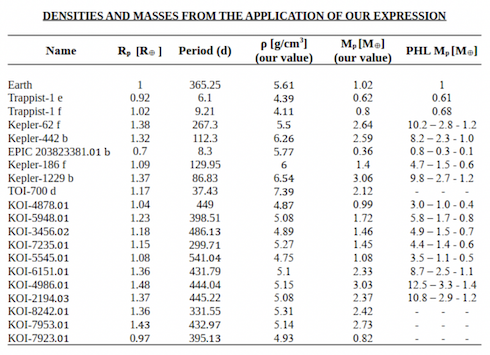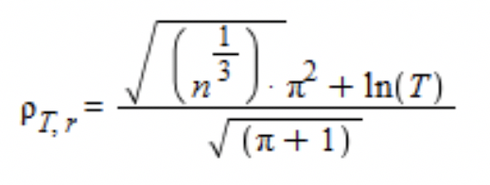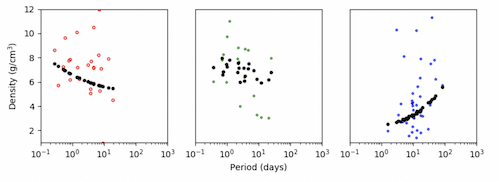On an Empirical Mathematical Approach to the Densities of Small Transiting Exoplanets
- Amateur astronomer, Greece, jm1983paros@gmail.com (email), j-m-1983@outlook.com (skype)
ABSTRACT
It has been observed, mostly from the findings of the Kepler mission, that the vast majority of Earth-like exoplanets, and small planets in general, are formed very close to their host stars. This comes into contradiction with the cases of planets in the size of Neptune and bigger that most likely form at longer distances and migrate closer to the star over time. Based on the findings of the Kepler telescope, it is suggested that there is a relationship between the radius and the formation distance. The bigger the radius, the greater the distance at which the planet will form, and the smaller the radius, the smaller the distance from the host star. In this work, we present an empirical approach for the derivation of the density for habitable-zone exoplanets with radii 0.6-1.5 Earth radii, without the knowledge of the mass of the planet. The 1.5 Earth radii limit was selected as objects up to this size are believed to be rocky. In general, it seems that, up to this limit, gravity continues to accumulate and compress matter, and as a result, density increases. This can also be observed for planets within the Fulton Gap (1.5–2.0 Earth radii). The densities of such objects most likely is the result of accreting heavier elements and of the existence of a core consisted of iron or other ferromagnetic compounds. For bigger planets the possibility of sustaining a solid surface decreases, but there is still some uncertainty on whether they are rocky or gaseous. Following the above, we present additional empirical approaches for the derivation of density for all exoplanets with radii 0.6-3.0 Earth radii. We split these planets in three categories: 0.6-1.5, 1.5-2.0 (Fulton Gap), and 2.0–3.0, regardless of the planets' orbital position.
1. INTRODUCTION
We experimented with a mathematical formula to derive the density of rocky exoplanets that are transiting, focusing to:
1) the absence of Doppler spectroscopy data. Knowing the density helps to directly derive the mass as we already know the radius (and as a result, the volume) from the observed transit dips. Our solution proved to be effective for the majority of transiting rocky exoplanets of our sample (Table, page 2) with a maximum radius of 1.5 Earth radii, given that such planets lie within the conservative habitable zone of their host stars.
2) cover the range of densities 2.9-8.5 g/cm3. The observables we use for our solution is the orbital period expressed in days, the mean motion of the exoplanet expressed in radians, and a factor that is related to, and dependent upon, the exoplanet/Earth radius ratio, expressed in Earth radii. We applied our mathematical expression for rocky-type exoplanets in the conservative habitable zone, and we saw the results to be close to the published values for many transiting exoplanets and candidates that are orbiting their parent stars inside their circumstellar, conservative habitable zones.
2. APPLICATION OF THE EXPRESSION FOR DENSITIES
We experimented with known predicted values for objects added to the HEC (Habitable Exoplanets Catalog) catalogue and we found our results to be in good agreement with the published values. As we are focused on the exoplanet discoveries made by Kepler, we developed our mathematical expression in absence of Doppler spectroscopy measurements for the vast majority of these exoplanets. The density formula for rocky exoplanets inside the habitable zone is:
where n=(2π)/Τ, with T expressed in days. For stars with effective temperatures lower than 0.7 times that of the Sun’s, the formula includes the ratio TSun/Tstar as a denominator.
It is important, though, in case of Earth-like planets that orbit M stars, to solve with both expressions for density. The reason is that M stars tend to allow the formation of Earth-like planets in a wide range of densities, e.g from planets like Trappist-1f (3.5 g/cm3) to planets like LHS-1140 b.
We applied our expression for densities for a list of 20 habitable-zone transiting exoplanets, and the results are shown in the table below. We also attempted to apply the first expression to the inner planets of the solar system, despite Mercury and Venus are not inside the habitable zone of the Sun. The deviations from the real values were ~12% for Mercury, ~3% for Venus, ~2% for the Earth and ~7% for Mars.

3. GENERAL EXPRESSIONS FOR EXOPLANETS BETWEEN 0.6 AND 3.0 EARTH RADII
a) Terran planets (0.6-1.5 Earth radii)
The general expression we use for the sub-category of Earths covers the range of densities 5.5-7.5 g/cm3. The expression makes use only of orbital period T (days), one of the two main observational parameters (together with the radius), extracted from the light curves. In this expression, as the orbital period increases, density tends to decrease, and vice versa. This is normal and correlates to other naturally inversely proportional ratios (ρ/r and m/r).

b) Exoplanets in the Fulton Gap (1.5-2.0 Earth radii)
The expression we use to calculate the densities for exoplanets inside the Fulton Gap makes use of both the radius rexo (Earth radii) and the orbital period T (days). It covers the range 6.0-8.5 g/cm3.
c) Exoplanets above the Fulton gap (2.0-3.0 Earth radii)
The expression for the exoplanets of this sub-category makes use of orbital period, T (days) and the radius rexo (Earth radii). It covers the range 2.9-5.5 g/cm3.
The diagram below shows a comparison between the measured densities for 89 exoplanets with known masses (with 30% maximum uncertainty) and the results of our formulas. For 62% of those planets the formulas give results with a deviation less than 30% (with data from exoplanet.eu).

ACKNOWLEDGEMENTS
The author expresses his gratitude to his friend Anastasia, especially, for all the encouragement to transform this idea into a work, as well as for her support during this effort; his brother Harry, also for being supportive; Dr. Angelos Tsiaras for his interest on this work, and the frequent communication with the author.
How to cite: Mantanikas, Y.: On an Empirical Mathematical Approach to the Densities of Small Transiting Exoplanets , Europlanet Science Congress 2020, online, 21 September–9 Oct 2020, EPSC2020-537, https://doi.org/10.5194/epsc2020-537, 2020

